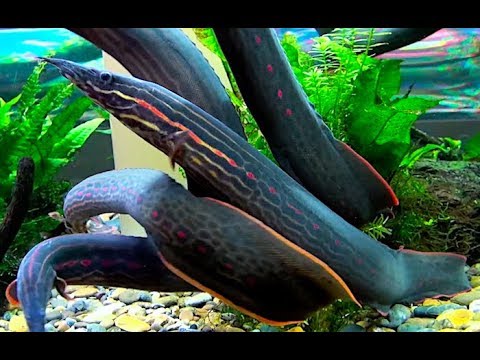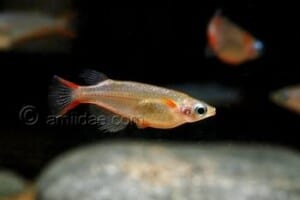Mastacembelus erythrotaenia – Fire Eel
Mastacembelus erythrotaenia was officially described in 1850 by Bleeker The genus name can be broken down into two ancient Greek words. Mastax means “to bite” and emballo means “to throw itself. Together, it means something like biting itself up somewhere. The species name erythrotaenia is also from ancient Greek and means “with red stripes.
Several common names are in use. Mostly it is called Fire Eel, sometimes Spotted Fire Eel.
They are part of the family Mastacembelidae or Spiny Eels. The family has 3 genera and about 86 species. They get their name from the clearly separated spines on their back. These spines are harmless to humans, by the way. The spiny eels can be distinguished from other eels by their long nose and tubular nostrils.
Synonyms: Macrognathus erythrotaenia, Mastacembelus argus.
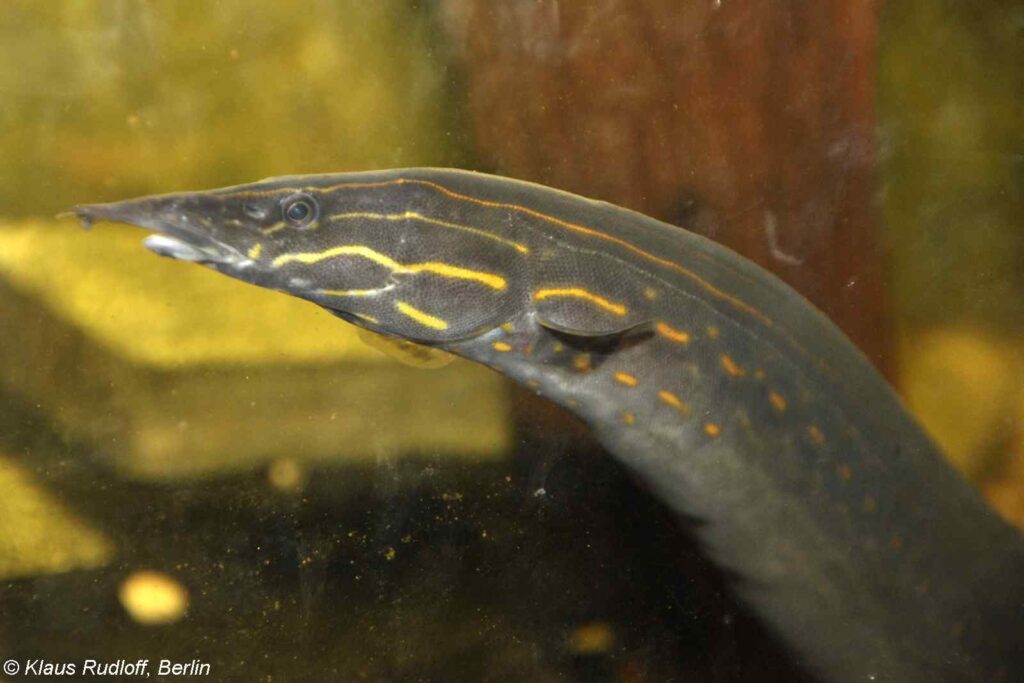
Tierpark Cottbus – Germany
Description
The Fire Eel can reach a total length of about 100 centimeters. In the aquarium, however, they tend to stay smaller. This makes it one of the largest spiny eels. They have a dark brown ground color. From the head, a few bright red stripes run towards the back. At about 1/5th of the body, these stripes turn into round red dots surrounded by a darker brown border. Some specimens have a red band on the pectoral, dorsal and caudal fins; others lack this red band. The ventral side is somewhat lighter in color.
The Fire Eel is a fairly calm fish. Usually they leave other species alone. You can tame them so they will come and get the food from a tweezer. For this you can use a whistle as a sign that there is something to eat. Some hold the food with their fingers. Then keep in mind that they may miss the food and bite your finger.
Behavior and Temperament
The Fire Eel is generally a peaceful fish, but can be aggressive toward conspecifics, especially in smaller aquariums. They are solitary in nature, but can also be kept in pairs or small groups, provided the aquarium is large enough. This fish is mainly a bottom dweller, but can also swim in the middle layers of the aquarium.
Fire Eels are nocturnal and avoid bright light, which means they often hide in hiding places or under the bottom cover during the day. This behavior makes it important to create plenty of hiding places in the aquarium, such as rocks, plants and other decorations. Consequently, they are most active at dusk and dark.
Sexual dimorphism
The difference between the male and female is hard to tell in Mastacembelus erythrotaenia. Males and females are similarly colored and the same length. Adult females seem to be slightly more full-bodied than the males, especially when carrying eggs. There are no differences in behavior either.
Juveniles versus Adult Specimens
Young Fire Eels usually have a grayish body with less pronounced colors and patterns. As they age, they develop the distinctive red stripes and darker coloration that adult specimens have. This color gradient is an important feature that helps identify the age and development of the fish.
Maximum age
When buying these fish, keep in mind that they can get quite old. With proper care they can reach an age of about 15 to 18 years! With the right aquarium setup, care and co-inhabitants you can enjoy your Fire Eels for a very long time! It is important to keep a close eye on the water quality and hygiene, because poor conditions can lead to diseases and a shorter lifespan.

Biotope
Mastacembelus erythrotaenia is native to several countries in Southeast Asia, including Laos, Cambodia, Indonesia, Malaysia, Thailand and Vietnam. This fish species lives mainly in the low-water areas of these countries, such as flood plains and slow-flowing rivers.
Distribution
The Fire Eel is a river fish found mainly in slow-flowing rivers and ponds. They are found in waters with muddy bottoms, where they often burrow in, with only their heads visible. This behavior helps them hide from both predators and catch their prey. In their natural habitat, they are often found in rivers such as the Mekong and in the waters of the deltas of the aforementioned countries.
Natural Habitat
The Fire Eels natural habitat is characterized by rich underwater vegetation. Plants are often abundant, providing shelter and helping to create a safe environment. The edges of the water are usually covered with trees and other vegetation, contributing to the biodiversity of the ecosystem. The bottom consists of a muddy or sandy substrate, which is ideal for this species of fish to burrow and hide in.
Natural Enemies and Food
In their natural habitat, Vuraal are both hunter and prey. They feed mainly on smaller fish, aquatic invertebrates and plant material. Their natural enemies are larger predatory fish that consider them food. This makes it essential for the Vuraal to camouflage themselves well in their environment.
Climate
The Fire Eel lives in a tropical climate, where temperatures are usually between 22 and 28 degrees Celsius. There are seasonal floods in these areas, especially during the rainy season, leading to a change in their habitat. These floods create new habitats and food sources, but can also lead to droughts in other seasons, affecting water and food availability.
In summary, the Fire Eel is a fish adapted to a specific ecosystem in Southeast Asia, where it can survive and thrive in the muddy, slow-flowing waters of its natural habitat.
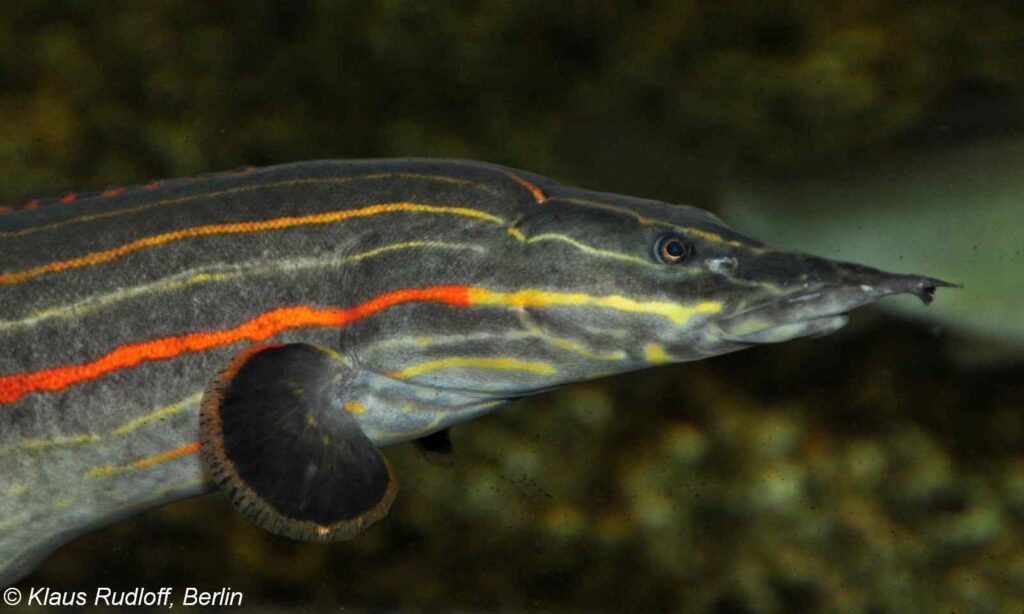
Leipzig Zoo – Germany
Diet
Food in the Wild
In their natural habitat, they are omnivorous, meaning they eat both plant and animal material. Their diet consists mainly of smaller fish, aquatic invertebrates such as insect larvae and worms, and small amounts of plant material. However, they have a clear preference for meaty foods such as shrimp and krill. This diet allows them to survive in the muddy bottoms of their habitat, where they can find and catch their prey.
Food in the Aquarium
In an aquarium, it is important to offer a varied diet consistent with their natural eating habits. Here are some recommendations for their diet:
- Live Food: Fire Eels love live food such as shrimp, mosquito larvae, and water fleas. This type of food stimulates their natural hunting instinct and provides a healthy diet.
- Frozen food: If live food is not available, frozen alternatives such as frozen shrimp and krill can be given. This is a convenient option for aquarium keepers.
- Meaty food: Larger specimens often need more than just live or frozen food. They can also be fed pieces of fish, such as smelt or mussels, to meet their nutritional needs.
- Plant Material: Although they are primarily carnivores, they can also accept small amounts of plant material. This can be in the form of specially designed fish food rich in plant ingredients.
It is important to make sure that the food you offer is of high quality and that you regularly check the water quality, as a poor diet and polluted water conditions can lead to health problems.
In the aquarium you can feed them with krill, shrimp, smelt etc. Frozen foods such as Daphnia, mosquito larvae and the like are eaten but ultimately do not contain enough nutrition for an adult Fire Eel!
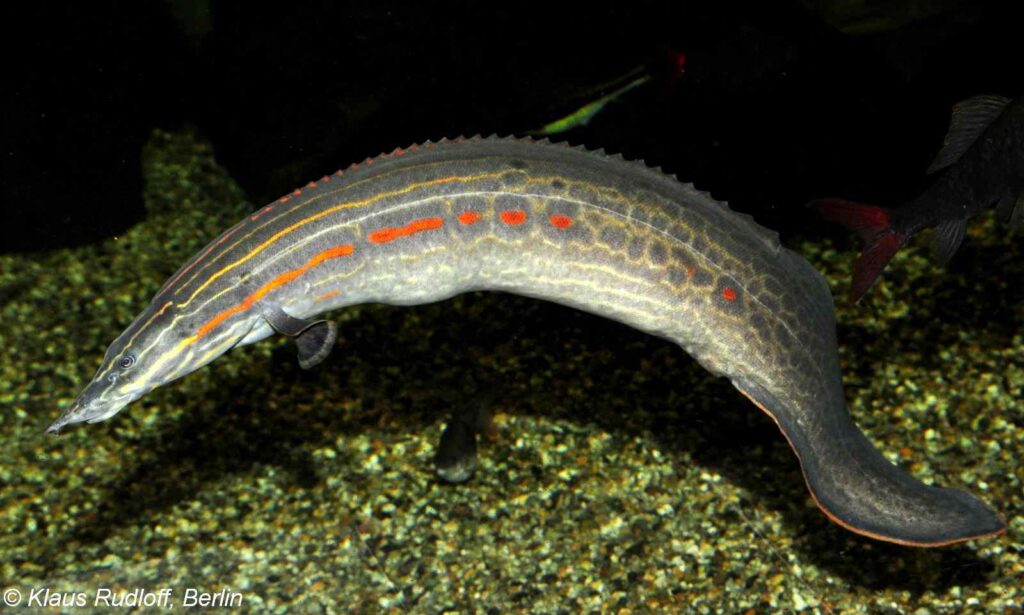
Leipzig Zoo – Germany
The Aquarium
Despite the fact that this will be a long fish, a relatively modest aquarium is required. An aquarium starting at 200 centimeters is sufficient. This corresponds to a capacity of about 500 liters. If you plan to keep several specimens or pairs, it is wise to choose an even larger aquarium, preferably with a length of 240 centimeters or more, to provide enough space and minimize territorial conflicts. For juveniles, however, you can use a smaller aquarium. Eventually, of course, they will become fish one meter in length!
The Aquarium
Aquarium setup is crucial to the well-being of the Fire Eel. Here are some guidelines for appropriate setup:
- Substrate: Use a soft sand as substrate, as this allows the Fire Eel to burrow and move comfortably. Avoid sharp gravel or other materials that can damage the fish’s skin.
- Plants and Hiding Places: Provide plenty of hiding places in the form of plants, PVC pipes, and rocks. These are shy fish that like to hide, especially during the day. Dense plant cover and hiding places help them feel safe.
- Lighting: Use a dimmed lighting to create a natural environment. Fire Eels are nocturnal and are most comfortable in a less brightly lit environment. It may be helpful to use a dimmer or light computer to adjust lighting to their natural rhythms.
Water parameters
The best water conditions for the Fire Eel in the aquarium are as follows: a temperature between 24 and 28 degrees Celsius, a pH value of 6.0 to 8.0, and a water hardness of 5 to 19 dGH. It is important to perform regular water changes to maintain water quality.
Compatibility with Other Residents
The Fire Eel is generally a peace-loving fish, but can be territorial toward conspecifics. It is best to keep them solitary or in a group of more than five in a spacious aquarium.
Suitable co-inhabitants include: large gouramis, knifefish, Geophagus spp., and Severums. These species are large enough not to be seen as prey and have similar temperaments.
Species that it is better not to keep together with this species are small fish, such as neon tetras or goldfish, as they can be seen as food. It is also advisable not to choose aggressive or territorial species, such as cichlids, which can harass the Fire Eel.
By following these guidelines, you can create a safe and comfortable environment for your Fire Eel, contributing to their well-being and longevity in the aquarium.

Leipzig Zoo – Germany
Night-active fish
Mastacembelus erythrotaenia is primarily a night active fish. This means they are most active during dusk and dark, while during the day they often hide in the substrate or among the plants and hiding places in the aquarium. This behavior is typical of many spiny eels, which in their natural habitat often burrow into the muddy bottom to protect themselves from predators and to hunt for prey.
Visibility for the Aquarium Keeper
To ensure you can see the Vuraal even when they are active at dusk or dark, there are several strategies you can employ:
- Use Night Lighting: Consider using night lighting or a blue LED bulb designed specifically for aquariums. This lighting simulates the natural conditions of the night and allows you to observe the Fire Eel without disturbing them with bright light. This can also help stimulate their natural behavior.
- Dimmable Lighting: Install a dimmable light in the aquarium. This allows you to adjust the brightness of the light so you can see the Fire Eel without overwhelming them with bright light. It may be helpful to gradually dim the lighting as the evening progresses.
- Strategic Placement of Decorations: Be sure to set up your aquarium so that there are plenty of hiding places, as well as open spaces where the Fire Eel can swim. This makes it easier to see them as they move around.
- Feeding times: Feed the Fire Eel at a time that matches their active periods, such as at dusk or just before dark. This can encourage them to come out and eat, allowing you to better observe them.
- Patience and Observation: Be patient and observe the aquarium during dusk or dark. It may take some time to see the Fire Eel, but with proper lighting and a properly set up aquarium, they will eventually exhibit their natural behavior.
By applying these techniques, you can enjoy the unique behavior of the Fire Eel, even when they are mainly active at night.
What To Do Against Escaping?
The Fire Eel is known as a master of escape. This fish tends to try to escape from the aquarium, especially if there are openings or holes through which they can crawl. This behavior can be problematic, as they can wriggle through even the smallest openings.
To prevent them from escaping, there are several measures you can take:
- Care for a Good Cover: Make sure the aquarium is well covered with a sturdy lid. This lid should fit well and leave no openings for the fish to slip through.
- Check Equipment: Check all equipment installed in the aquarium, such as filters and heaters. Make sure there are no holes or openings for the fish to escape through.
- Use of Filter Sponges: If there are openings for pipes or filters, use oversized filter sponges to block these holes. This prevents fish from escaping while still being able to use the equipment.
- Regular Inspection: Regularly inspect the aquarium for possible escape routes. This can help identify and resolve problems early.
- Create a Safe Environment: Make sure the aquarium provides plenty of hiding places so that the Fire Eels feel safe and less likely to escape. This can help lower their stress levels and promote their natural behavior.
By taking these measures, you can minimize the chances of Fire Eels escaping and ensure that they remain safe and healthy in their aquarium.
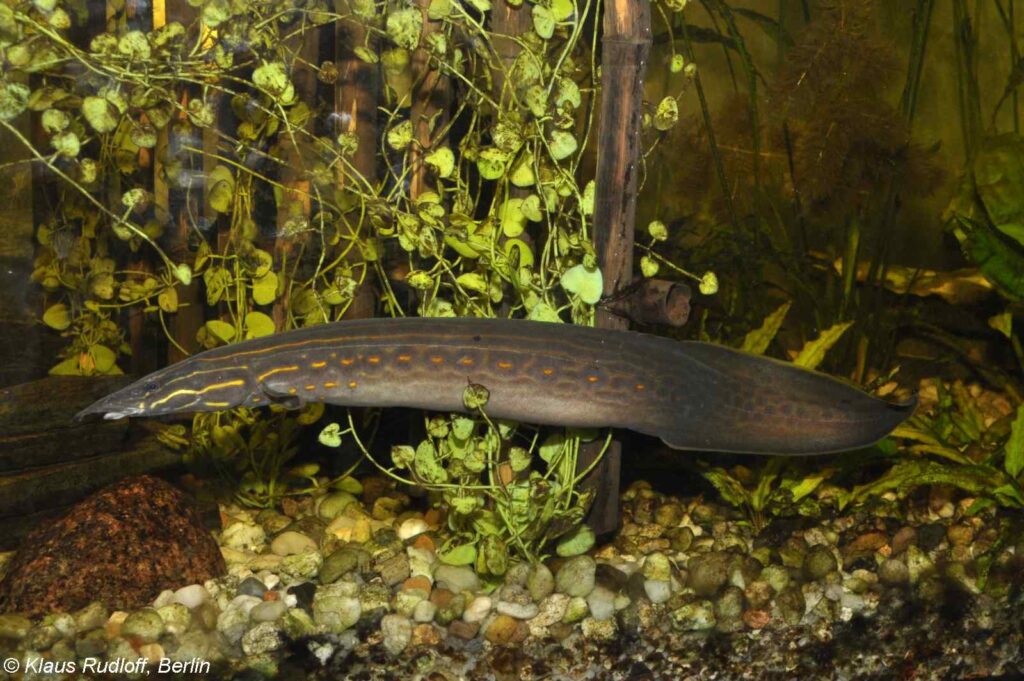
Tierpark Cottbus – Germany
Breeding of Mastacembelus erythrotaenia
Not much is known about the breeding of Mastacembelus erythrotaenia. Occasionally young fish are born in the aquarium. These are actually always accidental cultures. There is no indication of how to induce them to breed. The eggs are deposited between floating plants.
Conclusion
Mastacembelus erythrotaenia, or Fire Eel, is a fascinating fish that can be a unique addition to an aquarium, but requires the aquarist to be experienced. This species is not ideal for beginners, given their specific needs for water quality, setup and feeding. It is important to have a well-designed aquarium with plenty of hiding places and a secure cover to prevent escape.
Their nocturnal behavior and shyness make them challenging to observe, but with proper lighting and patience, aquarists can enjoy their unique character. Overall, the Fire Eel can be a valuable and interesting fish if given proper care and attention.
Video
Author
John de Lange
Copyright images
Klaus Rudloff – Biolib.cz
Nonn Panitvong – Siamensis.org (original website no longer online)
AquariumGlaser.de
Bibliografie
Unravelling taxonomic ambiguity of the Mastacembelidae in the Mekong Delta (Vietnam) through DNA barcoding and morphological approaches. Thuy-Yen Duong, Liem Van Dung Tran, Ngoc-Tran Thi Nguyen, Jamsari Amirul Firdaus Jamaluddin, Mohd Nor Siti Azizah. Tropical Zoology. PAGEPress Publications. DOI: 10.4081/tz.2020.72.
Characterization of complete mitochondrial genomes of Mastacembelus erythrotaenia and Mastacembelus armatus (Synbranchiformes: Mastacembelidae) and phylogenetic studies of Mastacembelidae. Chong Han, Qiang Li, Jianfeng Lin, Zhipeng Zhang, Jianrong Huang. Conservation Genetics Resources. Springer Science and Business Media LLC. DOI: 10.1007/s12686-017-0807-0.






![[HD] Hand Feeding another Fire Eel - Mastacembelus erythrotaenia -](https://aquainfo.nl/wp-content/cache/flying-press/ea3933c988942a1369ba126b4b04eb9c.jpg)

